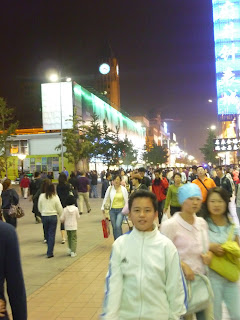We arrived at Wangfujing Street past 7.00pm. We were told before our arrival that we will see many branded foreign retailers along one side of Wangfujing Street and...

 ...find exotic snacks and food further down.
...find exotic snacks and food further down. Shoppers can walk freely on the road as it is off-limits to motor vehicles.
 Bag packs to the front. We were warned to be aware of snatch thieves.
Bag packs to the front. We were warned to be aware of snatch thieves. We were told by our guide that all imported goods sold in China have been taxed 300%. So, shopping there is not a good idea if you are looking for a good bargain.
We were told by our guide that all imported goods sold in China have been taxed 300%. So, shopping there is not a good idea if you are looking for a good bargain.You can't bargain when you shop at departmental stores...
 ...but you can try at shops selling local product, like this one...
...but you can try at shops selling local product, like this one... ...and small independent stores selling souvenirs.
...and small independent stores selling souvenirs.What is the best advice for shopping at stores in China where you can bargain? Just indicate your interest and then walk away. Don't turn back till the shop assistant runs after you with the item crying out the price you are willing to pay for. If you are lucky, you can get it at 100% lower than the offered price!














































